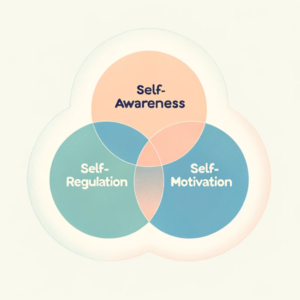BEING on an executive team or WORKING together on an effective executive team?
BEING in an executive team or WORKING together in an effective executive team?
Kristina Vallin
BEING in an executive team or WORKING together in an effective executive team?
Kristina Vallin
My early perception of executive teamwork might have been somewhat naive; to collectively create innovation, future visions, results for the ENTIRE company. To collaborate deeply with each other and be inspired by different perspectives, fostering effective executive teamwork. And indeed – there have been some really nice glimpses of that, but mostly I’ve been SITTING in the executive team. Not WORKING together, using our full potential as a team. Most of the time has been long stretches of very low contact and collaboration between the different parts of the group. Executive teamwork as a veritable reporting bunker instead of the collaborative and effective team that an executive group should strive to be.
Effective executive teamwork
Here are three puzzle pieces that effectively develop executive teamwork. These have truly helped me, both as a member of the executive team and in my role as a consultant helping executive teams to develop further. Puzzle pieces that move executive teams from being decisions concerning Christmas parties and reporting on own KPI:s, to strategic collaboration champions with responsibility for the whole.
Essentially, there are three questions that need to be answered; Why? What? and How?
Why does the executive team exist?
An exercise we at Doings usually do to sharpen the question of why the executive team (or the organization/team/business area/product/brand) exists, we call “R.I.P. The Executive Team”. A somewhat macabre title perhaps, but oh so effective as an exercise. It involves the group members putting words to what would be missing in the organization if the executive team disappeared right now.
The answers to the question can range from clear strategic leadership to cultural role models or enablers. In the next step, the group reflects on whether this is a desired or actual image. If it is desired (which it usually is), then the work is to define the steps to get there. A first puzzle piece in executive teamwork is now laid.
What is your common mission in the executive team?
I am still amazed at how many people never consider what the common mission of the executive team is and where it comes from. If you ask the question about the mission in an executive team, you will probably get almost as many answers as there are members.
In most cases, the executive team describes its mission based on the sum of the individual members’ different roles and missions. 1+1=2. And that is usually how incentive structures are built – to reward silo structures rather than the whole. This means in practice that the individual needs to report on the KPIs they are measured against.
But that is just part of the truth. The other part, and in the context of executive teams, the superior one, is the role as an executive team’s member. It’s something else and more, where 1+1= 33. It’s a role and mission where everyone wears the company hat (the whole), and where my own area (the part) is not primary. And how do you define that mission? It’s valuable to truly formulate the common mission in writing.
The executive team’s agenda
A corporate leadership has a responsibility for the whole, which also defines which issues should be on the agenda. Is this the forum for the Christmas party or rather for the overall culture? Can you critically look ahead? I.e., can you kill your darlings if it turns out to be a successful strategy for the whole company in the future? How do you view your brand and where it’s heading? I.e., how do you want current and future customers and employees to perceive you, and what can you as an executive team give each other to succeed as a whole?
When the agenda reflects the strategic level you as an executive team want to be at – then you have the second puzzle piece in place.
How do you create the results you want?
Who hasn’t been in a situation where awkward silence appears when someone challenges a bit too much, or just speaks their mind? Or, in the worst case, ridicule, rolling eyes, and deep sighs over that annoying person who never just goes along but always has objections or new perspectives.
A secure and stable executive team with the ability to handle disagreements in substance and make good use of each other’s different personalities also becomes a catalyst for results and a secure, creative, and productive organization. The executive team is literally always on stage. And the more openly you stand together and not as solo singers – the clearer you become as role models. So, it matters A LOT how you communicate within the group and outwardly in the organization. And the foundation of that lies within your effective executive teamwork.
Ground rules
A success factor for working with the “how”: i.e., articulated expectations you have of each other in meetings and in communication, is to define your ground rules. It’s a process that requires facilitated dialogue with both reflection, discussion, and decision-making. It can be difficult to see and articulate your own group’s dynamics and to facilitate them when you are a member of the group. Seeking help from a team coach or leadership developer in this process is recommended. Research shows that executive teams that seek support in this process significantly improve their effectiveness.
Ground rules are about ensuring that the culture you want the organization to have, also is reflected in the executive team’s collaboration. And culture is simply how you behave towards each other. So, ground rules are the set of behaviors you agree should apply for your effective executive teamwork, so that you live as you pray. Et voilà – puzzle piece number three in place! Now you’ve come a long way to get a much more enjoyable, maybe even joyful, collaboration in the executive team.
How do you do it?
Don’t set too many ground rules at the beginning, a handful may suffice. Some tips on ground rules and advice along the way:
- In the beginning, maybe it’s about hygiene factors in meeting habits? Such as prioritizing your meetings, being present, letting the phone be silent and off, and being well-informed about the topics to be discussed, etc.
- Ensure to discuss your communication on topics like which platforms to use for what topics, when you can expect responses from each other, how you handle urgencies et c. Also, discuss whether you should be expected to be online 24/7 or if there should be limitations. As mentioned, you’re building a culture for the entire company in how you behave in the executive group – so be mindful and diligent about what you create together.
- Ground rules mean nothing if they’re not followed up. Follow-up creates security! You must be able to give each other quick and constructive feedback when someone doesn’t play by your rules. And perhaps most importantly – heaps of positive feedback when you see someone struggling with a behavior and making progress.
- After a while when the ground rules are in place, it’s time to add new ones. Ground rules are alive and should evolve with you as a team. Maybe now you’ve come more to the level of how you treat each other? Maybe the ground rules are now about using your curiosity instead of your preconceived ideas? To use trust before control? To give feedback after each agenda item or meeting, etc.
Do you still think this sounds like a big challenge for your group? Don’t be a stranger – we’ll show you how we can coach your executive team on these issues. It’s fun, challenging, but above all, effective!
Kristina Vallin
Kristina Vallin
Share
Unlock the Potential in Your Organization with Self-Leadership at All Levels
Unlock the Potential in Your Organization with Self-Leadership at All Levels
Christian Fredriksson
Unlock the Potential in Your Organization with Self-Leadership at All Levels
Christian Fredriksson
We at Doings have had the privilege of supporting several of our clients in cultivating self-leadership within their organizations. The effects on both the participants in the programs and on the businesses have been significant. Therefore, we would like to share our experiences in the hope that more can harness the power within their organizations through self-leadership.
In Brief
Self-leadership aims to increase one’s ability to respond effectively to situations. In a turbulent time where adaptability and innovation are crucial for success, we see that the ability to lead oneself is what sets successful organizations apart. To succeed in your pursuit of self-leadership, it’s essential to design it in relation to the effects you wish to achieve.
What is Self-Leadership?
Unfortunately, there’s no single definition of self-leadership. Charles C. Manz defined it as “a process of exerting influence over oneself and one’s own behavior.” Simply put, self-leadership is the art of leading oneself. It aims to enhance one’s ability to respond effectively to the situations one faces.
Self-leadership is built on internal functions such as self-awareness, self-regulation, and inner motivation. It’s about strengthening awareness of how I function, what I value, how I tend to behave, and the effects of my behaviors. With increased awareness, I gain a greater ability to act “right.”

Increased self-awareness, in turn, gives me a greater capacity for self-regulation, allowing me to choose how I want to act, rather than instinctively react. The key to being able to act rather than react lies in the tiny amount of time that occurs between something happening and me taking action. In that small space, there’s an opportunity for me to choose my actions. By thoroughly reflecting on how my personal vision aligns with that of the organization, conditions are created to channel my energy into the right things with high motivation.
Why is Self-Leadership Important for Your Organization?
Many talk about how the world is complex and changing rapidly. I often ask myself what demands this places on leaders and organizations facing the challenge of navigating uncertain and turbulent waters. The key to success lies not only in having a good map in the form of wise strategic plans and effectively executing them. You also need to unleash and channel the intelligence of each employee so that together you can move the ship forward.

We believe that self-leadership cultivated at all levels of an organization is a strategic asset that can transform both individuals’ working lives and the organization’s overall performance. An added bonus is that increased self-leadership also has positive effects in all domains of life – both professional and private. In an organization where each employee feels responsible for their own leadership, an environment is created where innovation, engagement, and productivity flourish. As individuals develop the ability to effectively lead themselves, their decision-making, communication, and collaboration skills improve. This, in turn, strengthens the organization’s capacity as a whole.
So, How Do You Do It?
Promoting a culture of self-leadership involves more than just offering a course in self-leadership, although that’s a good start. A thoughtful learning strategy focuses on the effects your organization wants to achieve, and from there, a self-leadership program can be tailored.
Things to consider include, for example, what learning formats suit your employees. How can you create an encouraging climate where participants can experiment with new skills after completing training? How can you wisely shape learning groups that contribute to the desired effects (for example, strengthening relationships between parts of the organization)? In what order should employees and leaders take the program? And of course – what specific skills does your organization need to strengthen?
Our experience is that CEOs, management teams, leaders, and HR need to work together to create the best conditions for the organization to realize the effects of a self-leadership program. Not least because the strongest culture carriers in the company, often the management team, need to lead by example.
So, if you decide to give your organization and your employees the gift of a self-leadership education, I would like to conclude by saying: Congratulations and good luck!
And if you have any thoughts or questions, you are warmly welcome to contact us.
Here you can be inspired by Leila’s thoughts and experiences on when (the lack of) self-awareness gets in the way of change work. Interesting, we think!
Christian Fredriksson
Dela inlägget
When (lack of) self-awareness stands in the way of change
When (lack of) self-awareness stands in the way of change
Leila Ljungberg
When (lack of) self-awareness stands in the way of change
Leila Ljungberg
Have you ever experienced that work situation where everything seemed to be in order? The strategy was in place, communication was synchronized, everyone was ready and motivated. And then… nothing happened?
No matter how much we refine and calibrate in terms of direction and strategy, we often see that it doesn’t translate into action. The culprit? The human factor, as it might be stated in an incident investigation.
Change occurs at both the organizational and individual levels.
We work daily to help companies articulate their direction, vision, and create engagement around it. Identifying ways to strengthen behaviors and move towards their strategy is a key focus, all to bring about sustainable change.
For this to truly happen like magic, one crucial thing is required: individuals must be willing, prepared, and motivated to grow with the change. This entails strengthening their self-awareness. How do I act? What value does it create? How can I maximize the value without breaking?
When we work on both structure and culture at the organizational and individual levels, incorporating strategy and behavior, we observe faster progress, more efficient change, and increased engagement to contribute and find solutions. This lays the foundation for long-term change.
Self-awareness – or the lack thereof?
We live in a society where we are measured, driven, and quickly become accustomed to confirmation when we perform. It’s not uncommon for a crisis or a health condition to prompt us to start working on self-awareness and take care of ourselves. We argue that this work should start earlier and be continuous throughout life, especially in the fast-paced work environment where the pace of change is high.
It’s when we are in a recuperative state that we have the space to challenge ourselves. That’s when we have the energy and initiative to reflect on ourselves genuinely. It’s only then that we have the strength to receive feedback and act wisely. Self-reflection and personal development require, in addition to energy, both the will and courage from the individual. It also requires security and clarity from the cultural system, particularly evident in change efforts. When our clients work on direction, the cultural system, and individuals, we see that they succeed more extensively and sustainably.
Strengthen your self-awareness
Personal growth and increased self-awareness are, of course, lifelong endeavors. It means being incredibly curious about oneself and inspecting inwardly while adjusting outwardly. And it’s those continuous, good little habits that make the big difference. Here are three of our favorite reflections to nurture. Make it a habit to ask yourself these questions regularly:
- How do I want to be perceived by others? Why?
- What behaviors do I use to demonstrate that?
- What more can I do?
How do you increase your (and others’) self-awareness?
Leila Ljungberg
Share this post
TV-series and leadership
TV-series and leadership
Emma Forsgren
TV-series and leadership
Emma Forsgren
It’s autumn, and finally, we get to curl up on the couch and binge-watch series. Regardless of what I’m watching, the organizational and leadership enthusiast in me always finds parallels. I started with Ted Lasso (highly recommended!) mainly because the Queen of Psychological Safety, Amy Edmondson, recommended it as an entertaining example of creating psychological safety. Now, we’re watching Snabba Cash 2. Not for inspiration for good leadership, to say the least. On the contrary, I’m struck by how many would have survived if these guys had even a tiny, microscopic bit of good leadership in them. Instead of literally threatening someone’s life every time they disagree.
So, what’s the point of this? Most of us are lucky enough to avoid death threats at work, of course. However, really poor, controlling leadership still exists. And while it may not kill employees, it certainly kills the culture, motivation, collaboration, and all the other wonderful, fun, and successful aspects we desire in a workplace.
Control Leadership
- When I was in my twenties, I worked in an alpine village in Austria in the winters. It was seven absolutely fantastic years – I made friends for life, met my husband of almost 20 years, and learned everything I know about off-piste skiing, Tyrolean German, and après-ski. But also everything I know about really bad leadership. A few examples:
- When my employer heard that some kitchen staff had eaten ice cream in the kitchen after closing, he chose not to talk to them but instead installed surveillance cameras in the kitchen.Another employer called one evening to inform a loyal employee who had worked for him for many years that she didn’t need to come the next day. Or any other day, without any explanation or argument.
- While my kitchen colleagues were preparing a staff pasta (included in every 11-hour shift), made from the ends of the filet mignon (you know, the ones that don’t look as nice and can’t be sold), the boss walks into the kitchen and loudly says so all employees can hear: “What are you doing? That meat is too good for staff! Cook it up, and I’ll give it to Jimbo.”
Jimbo was her dog…
This was 20 years ago, but this type of leadership, which causes motivation and engagement to plummet like leaves on a stormy October morning, still exists today! And it contributes to the trend we are now seeing with quiet quitting, an increase in both mental health issues and poor work results. The other day, I heard, for example, that the new owners in a company put a note in the kitchen, among the fine china, and wrote “Management’s tableware” on it. Another workplace, sales-focused, had a Wall of Fame for the best sellers – and a Wall of Shame for the worst. Seriously. Today. How is this possible?
Trust before Control
I think it’s about forgetting to dare to trust each other. We are so conditioned to believe that control creates order that we forget there are other, much more effective paths. Especially for complex tasks that require collaboration (i.e., most of what we do today), research is abundantly clear that we need to feel motivated and psychologically safe to perform well. In the absence of trust, we create cracks, an ‘us and them’ feeling, frustration, and maybe even saboteurs. Conversely, with clear trust and a genuine belief that people want and can do their best if given the chance, we create a positive spiral of many wonderful things. Motivation, performance, inclusion, and ambassadors, for example.
Naive?
For those who might now be thinking, “But can you just trust people like that? That’s naive! You can be fooled and exploited.” To you, I want to say:
Try it! Take the risk. The next time you encounter a problem that needs solving, try, instead of building in more control, to let go of it. Invite. And choose to trust in people’s ability and willingness to contribute. Create conditions for employees to succeed and see what happens. Trust the process. The world needs more Ted Lassos. 😊
Emma Forsgren



